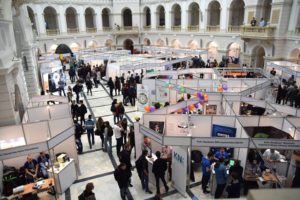 Warsaw University of Technology EPS Young Minds Section organised and participated in several events aiming to promote physics and science among children and local community. Physics can be fun and very attractive for young kids. Thanks to a grant from EPS, WUT section was able to demonstrate great new experiments adjusted to the age of participant. WUT EPS organised a visit to the local kindergarten with a fairytale full of optical phenomena. Kids were learning, while having a good time.
Warsaw University of Technology EPS Young Minds Section organised and participated in several events aiming to promote physics and science among children and local community. Physics can be fun and very attractive for young kids. Thanks to a grant from EPS, WUT section was able to demonstrate great new experiments adjusted to the age of participant. WUT EPS organised a visit to the local kindergarten with a fairytale full of optical phenomena. Kids were learning, while having a good time.
The section attended also the biggest outdoor science fair in Europe: “Science Picnic of Polish Radio and The Copernicus Science Centre” at the National Stadium in Warsaw.
It is Europe’s largest outdoor event aimed to promote science. Every year, it attracts crowds (over 100 thousand) of visitors to Warszawa. Scientific institutions, universities, research institutes, museums, cultural institutions, and foundations related to science and science clubs present their achievements and reveal the behind-the-scenes aspects of their everyday work. This year’s theme was: “Health and inventions”, so we tried to show how light-based technologies are used in medicine.
Next event the Warsaw section attended was organised by Warsaw University of Technology. It was an educational picnic “From micro to macro” for kids mainly from primary schools.
In september section organised a game: “Rycerze koherencji: W poszukiwaniu gargulca” and a lecture on holography, as a part of Warsaw Festival of Science.
The target of this event was students from primary and secondary school. A game in which the participants under the pretext of searching Gargoyle learn about the phenomenon, and devices used in optical measuring, among others, interferometry, thermal imaging, 3D scanning and luminescence. The lecture was prepared for older audience, so everyone could find something for themselves.
Sounds right? Sounds good!
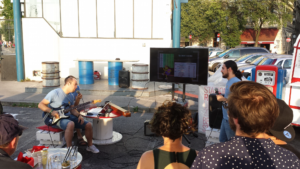 Besides the various big science events that take place in Trieste, we believe it is important to bring
Besides the various big science events that take place in Trieste, we believe it is important to bring
scientific dissemination to the general public also in its every day life. For this reason, we like to
organize events in pubs, to talk about science in a relaxed setting. Last summer, we had a talk
entitled “Sounds right? Sounds good!” about the physics of music at a pub, just before a local band
played some good music. With the help of a guitar and a string, we talked about how music is
described by waves, what spectral range we humans are able to hear and what the role of
harmonics is in the characteristics of the various music instruments.
Mini Maker Faire – Science Picnic
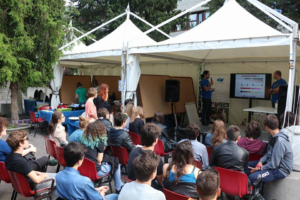 Trieste has a very high concentration of research centres. This results in various big scientific events,
Trieste has a very high concentration of research centres. This results in various big scientific events,
which gather people from the institutes and university to present their activity to the general
public. Among these events there are the Mini Maker Faire and the Science Picnic, which in 2016
took place consecutively at the International Centre for Theoretical Physics, in which we took part
with our own stand. There, we presented to the public facts about space science and the Solar
System. We had 3D-printed models of comet 67P/Churyumov-Gerasimenko and of the ESA Rosetta
probe, paper models of the Rosetta probe to give out to kids, posters on the Solar System and a
binocular, which projected on a cardboard the Sun and a solar spot.
Besides our stand, we had many time-slots to present our talks on the physics of music (“Sounds
right? Sounds good!”), the ESA Rosetta mission, the measurement of the cosmic microwave
background, and the observation of the sky in the infrared spectral range from the Antartic and
from space. In more detail, the measurement of the CMB was discussed with the aid of guitar, to
present it in analogy to the description of waves on a string. The talk on the observation of the
infrared sky was, instead, in the form of a double talk with two speakers, each arguing in favour of
his preferred kind of location.
The number of people reached in these events is large, since these attract people both from the city
and from the whole Friuli-Venezia Giulia region. The total number of visitors to the Mini Maker Faire
has been estimated by the organizers to be 18000. Given its success, we will participate also in the
2017 edition.
Poster session at the Physics Department
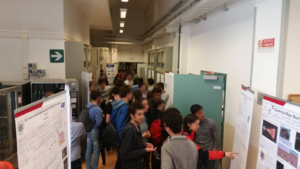 One of the goals of the Young Minds Project is to foster the networking among young researchers
One of the goals of the Young Minds Project is to foster the networking among young researchers
and students. As our first activity, we organized a spring poster session for the master and PhD
students of the Physics Department of the University of Trieste. The poster session took place in
the corridors of the Physics Department on the two days of the presentation to the students of the
Master Course in Physics and during the following week. The posters had, therefore, a high visibility
due both to the high number of people present for the Master Course presentation and to their
location in the core place of the Department’s life.
The posters numbered 16 and were presented by master and PhD students. Among the topics
covered we had high-energy astrophysics, quantum information, chemical evolution of galaxies,
out-of-equilibrium condensed matter, space and satellites physics, density functional theory
calculations, and stabilization of laser cavities. For the PhD students, the poster session has been
very useful to present their work to fellow PhD students and possible bachelor and master students
coming to their labs and groups for their internships or theses. To the master students, it provided
the opportunity to present for the first time their thesis work, a few months before the final
graduation defense.
In addition to the presenting students and to the audience, the activity was welcomed also by the
Professors, who encouraged their students to present a poster on their work. Given the success of
the activity, it will be repeated in late spring 2017.
Waves in physics and beyond
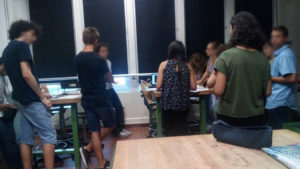 The recurrence in Trieste activities of the role of waves in physics motivated us to develop a more in-depth activity on waves. For this reason, we asked the Young Minds Project to finance the building of an educational model of spectrometer. Such spectrometer fits in a larger educational/outreach unit, in which we present to students and the general public the spectral analysis of waves.
The recurrence in Trieste activities of the role of waves in physics motivated us to develop a more in-depth activity on waves. For this reason, we asked the Young Minds Project to finance the building of an educational model of spectrometer. Such spectrometer fits in a larger educational/outreach unit, in which we present to students and the general public the spectral analysis of waves.
The concept of spectrum and of Fourier analysis is first introduced with a well-known object, the tuning fork. With the aid of a smartphone app, it is possible to show various aspects of sound waves, like the origin of harmonics and the spectrum of the human voice.
After the introduction of the concepts via sound waves, the spectral analysis of light allows to introduce more advanced concepts. A spectrometer allows, in fact, to see that not all light that appears as white is the same. Light from a light bulb, from a smartphone flashlight, or from discharge lamps can be shown to be different, introducing the concept of quantized energy levels in the atoms, in analogy with the discrete spectrum of a tuning fork.
This outreach unit was used for the first time in the context of a week-long college fair for 32 high school students visiting the Physics Department. In that occasion, we could use a spectrometer borrowed from a laboratory, to show the students how the spectra from the various sources look like. Afterwards, the students measured the spectrum of mercury with the home-built educational spectrometer, which is composed by a prism and a photodiode on a mechanical translator. Such rudimentary spectrometer is very useful from an educational point of view, since it allows the students to identify the key aspects in the measurement of a spectrum, such as a collimated incoming light beam and darkness in the lab. During the activity, the students were asked to answer a set of questions.
On the basis of our simple spectrometer, we are now supervising a high school student in her final-year project, for which she is building a more advanced educational spectrometer, whose draft layout is reported in the picture. This consists of a diffraction grating obtained from a DVD and a webcam sensor. While this spectrometer will be a closed-box instrument and will not be a hands-on object like the one described above, it allows to rapidly measure spectra. In the context of this student’s project, it will be used to measure the spectrum of differently coloured leaves.
We are also setting up a collaboration with a school in our region to prepare an experimental educational unit for high school students on thermal radiation and on the quantization of the atomic energy levels. Our estimate is that this will make us indirectly reach 40 students per year, since the class will be repeated every school year.
Finally, we are designing an object to illustrate the phenomenon of diffraction by a lattice. In particular, a lattice made of air balloons can produce a sound-waves diffraction pattern, in which people can literally walk.
Glasgow Science Festival and the European Researchers’ Night
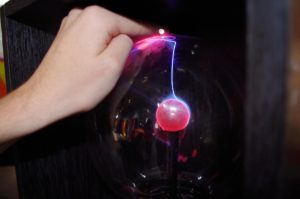 This past year SCOPE took part in the two main events for science outreach held in the city of Glasgow.
This past year SCOPE took part in the two main events for science outreach held in the city of Glasgow.
– Glasgow Science Festival (June).
During one weekend the Kelvingrove Museum in Glasgow hosts researchers from various fields to interact with the general public. It is an excellent opportunity for SCOPE to be able to explain different physical phenomena to everyone interested. This year the title of our activity was “Spilling the beams of light”. With a number of demonstrations and hands-on experiments for children and the entire family we explained how light works. The goal of our show was to cover the key features and properties of light, from understanding how the eye works to holograms. We also included several devices (polarizers, prisms, colours, 3D glasses..), each illustrating different phenomena. Four different set-ups were proposed, attracting around 250 people, mostly families with young children (aged 4-14).
– European Researcher’s Night ¨Explorathon” (September).
“A kingdom of optical illusions” was the title of our activity, and alongside other researchers from different fields, we organized hands-on activities aimed at younger children and families. With our demonstrations we wanted to cover some key features and properties of light, by using holograms, 3D glasses and plasma lamps.
The feedback for both activities has been very positive and the overall experience was excellent.
The 3D glasses workshop continues to be one of the most attractive activities, where children have the occasion to build their own glasses and play with them watching a short 3D movie as well as 3D pictures. Besides learning, children had fun with cutting and gluing their own glasses that they could take home afterwards.
All experiments were handled with kind assistance from the coordinators of the Science Festival and Explorathon, as well as volunteers from the University of Strathclyde’s Physics department and the Institute of Photonics.
Strathclyde’s Physics Journal Club
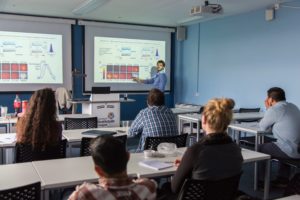 In 2016 Strathclyde SCOPE YM has successfully run the Strathclyde’s Physics Journal Club fortnightly with really good acceptance and collaboration from the students involved. The aim of this activity was to both give the chapter members the opportunity to present some of the relevant papers in their field or more generally in general interest science and also enhance the communication with other students, learning and talking about physics in a relaxed atmosphere. As many of the students were lacking this kind of activities in their own groups, we provided this student-run platform with great success.
In 2016 Strathclyde SCOPE YM has successfully run the Strathclyde’s Physics Journal Club fortnightly with really good acceptance and collaboration from the students involved. The aim of this activity was to both give the chapter members the opportunity to present some of the relevant papers in their field or more generally in general interest science and also enhance the communication with other students, learning and talking about physics in a relaxed atmosphere. As many of the students were lacking this kind of activities in their own groups, we provided this student-run platform with great success.
Throughout the year, we had the chance to learn about a whole variety of physics subjects from quantum optics to optogenetics. The participants ranging from 10 to 20 people with high regularity chaired at least one session during this period. The presentation was usually 20 to 30 minutes long, followed by an informal discussion with some refreshments. During the presentation most of the participants will make use of both whiteboard sketches and projector slides to support their speech. The rest of the students provided some feedback after the presentation helping the speakers improve their weaker points during the presentation.
We consider that this activity was helping to develop a vital skill for junior scientists which is the ability to efficiently analyze and present a high-profile scientific paper. The fact that this activity was held in a student atmosphere helped reducing the fear of some participants to make mistakes and allowed them to expand their knowledge in a much less anxious way.
We regularly asked for feedback to our participants and adapted the sessions to their needs. The atmosphere was really friendly during the sessions and we are certain that this activity will remain valued by the students in the coming years.
Spreading Optics in the school
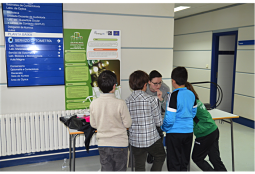 As it is usual in the USC-EPS Young Minds Section, we have performed several outreach activities in local Schools. Those activities are addressed to students from 5 up to 18 years old. In order to overcome the high range of ages we have, we offer to the schools a set of activities that will be tuned in order to fit with their necessities.
As it is usual in the USC-EPS Young Minds Section, we have performed several outreach activities in local Schools. Those activities are addressed to students from 5 up to 18 years old. In order to overcome the high range of ages we have, we offer to the schools a set of activities that will be tuned in order to fit with their necessities.
During the last year we have visited 4 local schools to develop our experiments mainly with children of primary school (below 12). However, we have performed some outreach activities in the faculty (2 activities with a total of 50 students). This new approach allow us to perform some experiments that can not be done in the schools, for example, a hologram activity where children learn about the nature of those items and how it can be built. The experiments in the faculty has some drawbacks, like the renting of some space to perform these experiments. In this case we have pushed the university to collaborate with the section in order to use some space for free.
As it was stated in the grant application, we asked for money in order to buy some optical elements that usually get broken during the activities (specially when small children are involved) like polarizers, diffraction gratings, etc. In this particular case we have bought thin film polarizers that are the easiest item to lose when we perform our experiments.
In conclusion, we considered that a natural step for our section is to push the schools to come to the faculty, where new experiments can be done avoiding their transportation. With this approach we can also offer visits to the faculty and their labs focused on pre-university students.
Play with water
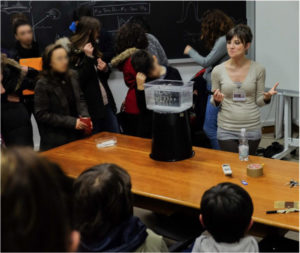 Sharing our knowledge with anyone who is not an expert is always so nice, especially when it comes to dealing with curious people and especially with kids, those who have thousands of interesting questions all the time.
Sharing our knowledge with anyone who is not an expert is always so nice, especially when it comes to dealing with curious people and especially with kids, those who have thousands of interesting questions all the time.
In 2016 the Rome Young Minds Section organized several interactive activities for the public during two events at the Department of Math and Physics of Roma Tre, namely “Eyes on the Moon” and “Eyes on Jupiter”. During these events there is a large public participation involving people of all ages, from kids to high school students to ordinary citizens (about 1400 particpants in total).
The topic of our activities is mainly focused on:
– water dealing with issues such as Archimedes’ principle, capillarity and the surface tension of liquids (hands-on labs).
– optics laws. The purpose of the activity was to provide an opportunity to discover optics (geometrical and physical) by means of hands-on labs.
– interactive exhibition about Jupiter and its moons. This activity was organized by means of printed images and interactive web sites, some of which created by us for this event (https://roma3astrogarden.wordpress.com/). The exhibition was animated for people browsing around, giving them the chance to discover Jupiter’s moons, its stunning auroras, the missions that are now studying the planet, and the large range of phenomena linked to it. This activity was run with the help of some third high school year students.
– the Earth and the Moon. We built a model of the Earth, the Moon and the Sun orbiting around each other (orrery) to show why the Moon is mischievous and always shows the same face. And what about the seasons? This orrery helped in getting the answers to these and many other curiosities, such as lunar phases and tides.
-the eye and the 3d vision. An experiment focused on eye’s functionality, divided into three steps: the anatomical components of a healthy eye, how these components work together, and why, if one eye works perfectly alone, we have two of them? In this regard, a demonstration on how our brains are able to make us understand the three-dimensions, using a stereoscope, was given. Moreover was explained the concept of the cinema 3D vision, with practical demonstration of the three-dimensional view of a siderite through anaglyph glasses.
Popular Science Writing Course 2016
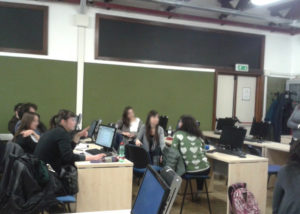 On March the 3rd and the 4th at University “La Sapienza” Physics Department was held the workshop on scientific writing “Laboratorio di scrittura divulgativa” .
On March the 3rd and the 4th at University “La Sapienza” Physics Department was held the workshop on scientific writing “Laboratorio di scrittura divulgativa” .
The workshop, mainly addressed to PhD students in scientific subjects (physics, chemistry, biology), was intended to give to the participants the basic tools on the non-academic scientific writing: the students would learn how to write articles for the general public instead of papers for the academic community.
To achieve this aim, the workshop was held by Manuela Cirilli and Massimiliano Razzano, both physicists and science communicators. Manuela Cirilli, in fact, is a particle physicists who works in the Knowledge Transfer Group of CERN, while Massimiliano Razzano is an astrophysicists and a professional journalist who writes for some of the most popular italian newspapers.
The workshop was divided in two days corresponding to two main parts. During the first part there was a theoretical introduction about the scientific communication in general, with a particular focus on the non-academic scientific writing. The second part of the workshop was instead more practical, because the participants were asked to become journalists themselves: under the guidance of the teachers, the students simulated an editorial meeting and wrote their own scientific articles. In this way, they learned not only how to present to the general public their scientific work in a more intriguing way, but also how to interact with the editorial staff.
This year we organised also a social event at the end of the course, in collaboration with the “Assaggi” bookstore, to present section activities to physics student and increase the section active members.
